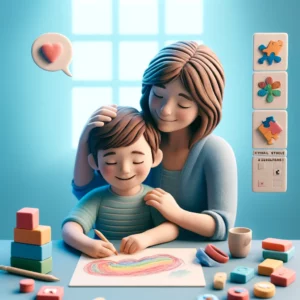Emotional intelligence (EQ) is just as critical as academic skills for your child’s success—both in preschool and beyond. In 2025, with growing awareness of mental health and holistic child development, fostering social-emotional learning (SEL) has become a top priority for parents and educators. This guide shares practical activities, mindfulness techniques, and daily habits to nurture your child’s emotional growth.
Why Emotional Intelligence Matters in Early Childhood
What Is Emotional Intelligence?
Emotional intelligence includes four core skills:
- Self-Awareness: Recognizing and naming emotions.
- Empathy: Understanding others’ feelings.
- Self-Regulation: Managing big emotions like anger or frustration.
- Social Skills: Building positive relationships.
Studies show that children with strong EQ perform better academically, resolve conflicts peacefully, and form healthier friendships .
5 Activities to Boost Emotional Intelligence
1. Emotion Charades
How to Play:
- Write emotions (happy, sad, scared, excited) on cards.
- Have your child act out the emotion while others guess.
Why It Works: Helps children identify and express feelings verbally.
2. Mindfulness Breathing Exercises
Activity: Teach your child “balloon breathing”:
- Inhale deeply through the nose (imagine filling a balloon).
- Exhale slowly through the mouth (deflating the balloon).
Tip: Pair this with calming music for a mindfulness moment before bedtime.
3. Storytime with Feeling Words
Strategy: Read books that highlight emotions, like The Color Monster or In My Heart: A Book of Feelings.
- Pause to ask: “How do you think the character feels? Have you ever felt that way?”
4. Empathy-Building Role-Play
Example: Use stuffed animals to act out scenarios like sharing toys or comforting a friend.
- Ask: “How would you help Bear feel better if he’s sad?”
5. Gratitude Journals for Kids
Activity: Create a simple journal where your child draws or dictates one thing they’re thankful for each day.
Pro Tip: Model gratitude by sharing your own examples at dinner.
How Preschools Support Social-Emotional Learning
SEL-Focused Curriculum
Many preschools now integrate SEL into daily routines through:
- Morning check-ins: “How are you feeling today?”
- Conflict resolution circles: Teaching kids to use “I feel” statements.
Teacher Training in Emotional Development
Look for preschools where teachers are trained in:
- Positive reinforcement: Praising effort, not just results.
- Emotion coaching: Helping children navigate tantrums or anxiety.
Tackling Common Challenges
Handling Tantrums with Calm-Down Corners
Create a Safe Space: Fill a corner with soft pillows, sensory toys, and emotion cards.
- Teach your child to visit this space when overwhelmed to practice self-regulation.
Addressing Separation Anxiety
Strategy: Use a “goodbye ritual” (e.g., a special handshake or sticker exchange) to build trust and consistency.
Partnering with Your Preschool
Collaborate with teachers to reinforce SEL at home:
- Ask for updates on your child’s social interactions.
- Share what emotional skills you’re working on at home.
Example: If your child struggles with sharing, the teacher can create group activities to practice teamwork.
Conclusion
Building emotional intelligence in preschoolers isn’t about perfection—it’s about giving children the tools to understand and manage their feelings. By incorporating mindfulness practices, empathy-building games, and open conversations, you’ll empower your child to thrive emotionally and socially in 2025 and beyond.




